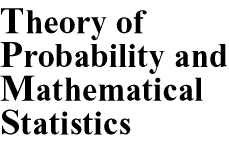Limit behavior of symmetric random walks with a membrane
Authors:
A. Yu. Pilipenko and Yu. E. Pryhod’ko
Translated by:
S. Kvasko
Journal:
Theor. Probability and Math. Statist. 85 (2012), 93-105
MSC (2010):
Primary 60F17, 60J10
DOI:
https://doi.org/10.1090/S0094-9000-2013-00877-1
Published electronically:
January 14, 2013
MathSciNet review:
2933706
Full-text PDF Free Access
Abstract |
References |
Similar Articles |
Additional Information
Abstract: Let $\{X(k), k\in \mathbb {Z}_+\}$ be a random walk in $\mathbb {Z}$. Assume that its transition probabilities coincide with those of a symmetric random walk with unit steps throughout except for a fixed neighborhood of zero. The weak convergence of the sequence of normalized walks $\{X_n(k) = n^{-1/2} X(nk),k\geqslant 0\}_{n\geqslant 1}$ is proved. The main result generalizes a Harrison and Shepp theorem on the weak convergence to a skew Brownian motion in the case where the symmetricity of the random walk fails at a single point. All possible limits for the corresponding random walks are described.
References
- W. Feller, An Introduction to Probability Theory and its Applications, second edition, vol. 1, John Wiley & Sons, Inc. and Chapman and Hall, Ltd., New York and London, 1957.
- Patrick Billingsley, Convergence of probability measures, John Wiley & Sons, Inc., New York-London-Sydney, 1968. MR 0233396
- J. M. Harrison and L. A. Shepp, On skew Brownian motion, Ann. Probab. 9 (1981), no. 2, 309–313. MR 606993
- M. I. Portenko, Diffusion in a medium with semi-transparent membranes, Proceedings of the Institute of Mathematics of National Academy of Science of Ukraine, vol. 8, Kyiv, 1994. (Russian)
- R. A. Minlos and E. A. Zhizhina, A limit diffusion process for an inhomogeneous random walk on a one-dimensional lattice, Uspekhi Mat. Nauk 52 (1997), no. 2(314), 87–100 (Russian); English transl., Russian Math. Surveys 52 (1997), no. 2, 327–340. MR 1480138, DOI https://doi.org/10.1070/RM1997v052n02ABEH001778
- A. S. Cherny, A. N. Shiryaev, and M. Yor, Limit behaviour of the “horizontal-vertical” random walk and some extensions of the Donsker-Prokhorov invariance principle, Teor. Veroyatnost. i Primenen. 47 (2002), no. 3, 498–517 (English, with Russian summary); English transl., Theory Probab. Appl. 47 (2003), no. 3, 377–394. MR 1975425, DOI https://doi.org/10.1137/S0040585X97979834
- J. K. Brooks and R. V. Chacon, Diffusions as a limit of stretched Brownian motions, Adv. in Math. 49 (1983), no. 2, 109–122. MR 714586, DOI https://doi.org/10.1016/0001-8708%2883%2990070-1
- M. I. Freidlin and A. D. Wentzell, Diffusion processes on an open book and the averaging principle, Stochastic Process. Appl. 113 (2004), no. 1, 101–126. MR 2078539, DOI https://doi.org/10.1016/j.spa.2004.03.009
- A. M. Kulik, A limit theorem for diffusions on graphs with variable configuration, ArXive:math.PR/0701632.
References
- W. Feller, An Introduction to Probability Theory and its Applications, second edition, vol. 1, John Wiley & Sons, Inc. and Chapman and Hall, Ltd., New York and London, 1957.
- P. Billingsley, Convergence of Probability Measures, John Wiley & Sons, Inc., New York–London–Sydney, 1968. MR 0233396 (38:1718)
- J. M. Harrison and L. A. Shepp, On skew Brownian motion, Ann. Probab. 9(2) (1981), 309–313. MR 606993 (82j:60144)
- M. I. Portenko, Diffusion in a medium with semi-transparent membranes, Proceedings of the Institute of Mathematics of National Academy of Science of Ukraine, vol. 8, Kyiv, 1994. (Russian)
- R. A. Minlos and E. A. Zhizhina, Limit diffusion process for a non-homogeneous random walk on a one-dimensional lattice, Uspekhi Matem. Nauk. 52:2(314) (1997), 87–100; English transl. in Russian Math. Surveys 52(2) (1997), 327–340. MR 1480138 (99b:60112)
- A. S. Cherny, A. N. Shiryaev, and M. Yor, Limit behavior of the “horizontal–vertical” random walk and some extensions of the Donsker–Prokhorov invariance principle, Theory Probab. Appl. 47 (2003), no. 3, 377–394. MR 1975425 (2004b:60121)
- J. K. Brooks and R. V. Chacon, Diffusions as a limit of stretched Brownian motions, Adv. Math. 49 (1983), 109–122. MR 714586 (84j:60040)
- M. I. Freidlin and A. D. Wentzel, Diffusion processes on an open book and the averaging principle, Stoch. Process. Appl. 113, no. 1, 101–126. MR 2078539 (2005e:60178)
- A. M. Kulik, A limit theorem for diffusions on graphs with variable configuration, ArXive:math.PR/0701632.
Similar Articles
Retrieve articles in Theory of Probability and Mathematical Statistics
with MSC (2010):
60F17,
60J10
Retrieve articles in all journals
with MSC (2010):
60F17,
60J10
Additional Information
A. Yu. Pilipenko
Affiliation:
Institute of Mathematics of National Academy of Science of Ukraine, Tereshchenkivs’ka Street 3, 01601, Kyiv, Ukraine
Email:
apilip@imath.kiev.ua
Yu. E. Pryhod’ko
Affiliation:
National Technical University of Ukraine “KPI”, Department of Mathematical Analysis and Probability Theory, Peremogy Avenue 37, 03056, Kyiv, Ukraine
Email:
npuxodbko@gmail.com
Keywords:
Random walks,
skew Brownian motion,
diffusion with a membrane
Received by editor(s):
September 3, 2010
Published electronically:
January 14, 2013
Additional Notes:
Partially supported by a grant of State Foundation for Fundamental Researches of Ukraine and Russian Foundation for Fundamental Researches (grant # $\Phi$40.1/023)
Article copyright:
© Copyright 2013
American Mathematical Society




